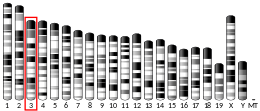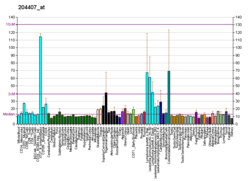TTF2
Transcription termination factor 2 is a protein that in humans is encoded by the TTF2 gene.[5][6]
This gene encodes a member of the SWI2/SNF2 family of proteins, which play a critical role in altering protein-DNA interactions. The encoded protein has been shown to have dsDNA-dependent ATPase activity and RNA polymerase II termination activity. This protein interacts with cell division cycle 5-like, associates with human splicing complexes, and plays a role in pre-mRNA splicing.[6]
References
- GRCh38: Ensembl release 89: ENSG00000116830 - Ensembl, May 2017
- GRCm38: Ensembl release 89: ENSMUSG00000033222 - Ensembl, May 2017
- "Human PubMed Reference:". National Center for Biotechnology Information, U.S. National Library of Medicine.
- "Mouse PubMed Reference:". National Center for Biotechnology Information, U.S. National Library of Medicine.
- Liu M, Xie Z, Price DH (October 1998). "A human RNA polymerase II transcription termination factor is a SWI2/SNF2 family member". The Journal of Biological Chemistry. 273 (40): 25541–4. doi:10.1074/jbc.273.40.25541. PMID 9748214.
- "Entrez Gene: TTF2 transcription termination factor, RNA polymerase II".
- Leonard D, Ajuh P, Lamond AI, Legerski RJ (September 2003). "hLodestar/HuF2 interacts with CDC5L and is involved in pre-mRNA splicing". Biochemical and Biophysical Research Communications. 308 (4): 793–801. CiteSeerX 10.1.1.539.8359. doi:10.1016/S0006-291X(03)01486-4. PMID 12927788.
Further reading
- Girdham CH, Glover DM (October 1991). "Chromosome tangling and breakage at anaphase result from mutations in lodestar, a Drosophila gene encoding a putative nucleoside triphosphate-binding protein". Genes & Development. 5 (10): 1786–99. doi:10.1101/gad.5.10.1786. PMID 1916263.
- Hara R, Selby CP, Liu M, Price DH, Sancar A (August 1999). "Human transcription release factor 2 dissociates RNA polymerases I and II stalled at a cyclobutane thymine dimer". The Journal of Biological Chemistry. 274 (35): 24779–86. doi:10.1074/jbc.274.35.24779. PMID 10455150.
- Leonard D, Ajuh P, Lamond AI, Legerski RJ (September 2003). "hLodestar/HuF2 interacts with CDC5L and is involved in pre-mRNA splicing". Biochemical and Biophysical Research Communications. 308 (4): 793–801. CiteSeerX 10.1.1.539.8359. doi:10.1016/S0006-291X(03)01486-4. PMID 12927788.
- Jiang Y, Liu M, Spencer CA, Price DH (May 2004). "Involvement of transcription termination factor 2 in mitotic repression of transcription elongation". Molecular Cell. 14 (3): 375–85. doi:10.1016/S1097-2765(04)00234-5. PMID 15125840.
- Colland F, Jacq X, Trouplin V, Mougin C, Groizeleau C, Hamburger A, Meil A, Wojcik J, Legrain P, Gauthier JM (July 2004). "Functional proteomics mapping of a human signaling pathway". Genome Research. 14 (7): 1324–32. doi:10.1101/gr.2334104. PMC 442148. PMID 15231748.
- Jiang Y, Price DH (September 2004). "Rescue of the TTF2 knockdown phenotype with an siRNA-resistant replacement vector". Cell Cycle. 3 (9): 1151–3. doi:10.4161/cc.3.9.1151. PMID 15467445.
This article is issued from Wikipedia. The text is licensed under Creative Commons - Attribution - Sharealike. Additional terms may apply for the media files.




